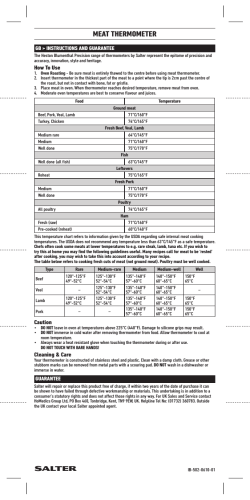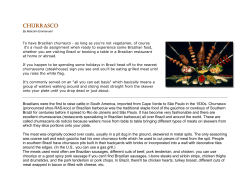
Document 204766
Outlook for the global meat industry 14 September 2010 Rabobank: A leading Food & Agribank Presence in 41 countries New perspectives World growth indicators and drivers for agriculture Nan-Dirk Mulder, Rabobank International How to reach sustainable growth in a much more dynamic industry? Competition for food: what’s next? 700 600 500 2006Globalisation of industry 2006Commodityprice volatility 2008Exchange-rate volatility 2008Economic crisis Next: -Sustainability -Animal welfare - Volatility -Trade liberalisation vs protectionism 400 300 200 100 0 Market dynamics and animal diseases 1 Corn Wheat Rice Soy Beans R Outlook for the global meat industry 14 September 2010 What is driving commodity prices? Key challenge: Global food supply Policies • • • • • Trade Policy Agricultural Policy Biofuel/Energy policy Food safety regulations (e.g. GMO) Sustainability criteria Supply factors • • • • • • Meat demand Food demand Fuel demand Meat supply Food supply Fuel supply Demand factors Agricultural land Yield (output/ha) Farm management Farm input prices Weather Diseases • • • • Commodity price Feed Food Biofuels Industrial • • • • • • • Source: Rabobank, 2009 Expansion Efficiency Yield Livestock/poultry supply Other price determining factors Livestock supply Fund activity Exchange rates Freight rates Crude oil prices Technical specifications Market sentiment and speculation New non-agri market entrants Grains and oilseed supply ??????? How to produce? How to produce 500 million tonnes? Global demand for agriculture (change 2008-18) Grains and oilseeds Sugar Livestock and dairy Biofuel Additional demand: 500 m. tonnes De Grains and oilseeds markets 2008-2018 200% Wheat Coarse grains Rice Oilseeds 180% 160% Share developing Market volume growth Growth % markets + 70 million tonnes 10% 72% + 190 million tonnes 17% 50% + 46 million tonnes 10% 98% + 133 million tonnes 20% 78% 140% Demand for agriculture 2008-18 De 100% 80% Brazil 54% Food, feed, fuel demand 2020 Additional Yield improvement Food, feed, fue l demand 2010 40% LOW Wheat Coarse grains Rice Oilseeds Beef Pigmeat Source: OECD, FAO, Rabobank estimate, 2009/10 2 HIGH YIELD 0% Poultry Milk Sugar Ethanol Biodiesel Feed/Animal protein, 190 million tonnes EU-27 11% Hectares Food, 180 million tonnes 20% U.S. 11% FSU 21% Fuel, 130 million tonnes 60% Unused arable land: 180 million hectares South Africa 3% HECTARES 140 million 120% Efficiency Cultivation Yield Land use Great challenge for sector: Fast-growing demand for agricultural products 220% +20% in 10 years 30% yield increase Grains yield (tonnes/ha) in 2007/2008 Wheat Corn Brazil 2,100 3,800 EU-15/27 4,830 6,480 Russia 2,020 3,790 Ukraine 2,340 4,210 U.S. 2,720 9,660 Source: OECD, 2009 R Outlook for the global meat industry 14 September 2010 70% of global growth in demand for meat will be in Asia Who’s going to produce world meat demand? Market growth estimate for key meat markets 2010-2020 Broiler cost of production (USD/kg) 25 000 25,000 Pigs cost of production EUR/kg cwe 1.2 20,000 1,80 1,60 1 1,40 0.8 15,000 1,61 1,40 1,20 1,04 1,00 0.6 10,000 1,62 1,57 1,40 0,91 0,80 0,60 0.4 0,40 0.2 5,000 0,20 - 0 US - BRA ARG EU RUS CHI THA IND NL DE DK ES PL US BR Source: Rabobank estimate -5,000 10% of global production is traded internationally S R Poultry FAO FAPRI OECD Beef Pork Future meat production growth Water issues will start to bite Global meat production 2009 – 2018 (1,000 tonnes and CAGR 2009-2018) 100,000 90,000 +2.3% 80,000 70,000 60,000 50,000 +1.0% 40,000 +0.5% +3.5% 30,000 , 20,000 +4.0% 10,000 +2.6% +1.0% +1.8% +0.3% - Source: Rabobank/OECD, 2010 3 Poultry Pork Beef R Outlook for the global meat industry 14 September 2010 Importance of land quality will increase ‘Ring of fire’ region as future spearhead in global trade Rabobank International A fast-changing global meat industry landscape 1,000 tonnes 14,000 Global ranking: Meat companies The beef industry most consolidated industry on global level Consolidation in the global meat industry 12,000 , 100% 90% 10,000 80% 8,000 70% 60% 6,000 50% 4,000 40% 2 000 2,000 30% 20% - +2% 10% 0% 20% 7% Pork * Including Bertin, Pilgrim's Pride ** Merger Perdigão, Sadia Source: Rabobank estimate based on public sources 4 Poultry Beef Pork 20% 7% Beef Other +1% 9% Poultry Pipeline 9% 7% +2% Meat 7% 7% Feed Top 3 market share Source: Rabobank estimate R Outlook for the global meat industry 14 September 2010 Brazilian and US companies drive global consolidation process in meat industry Bounce back: dealing with volatility as key successfactor for whole value chain Grains and oilseeds Feed Farming Processing Customer Market M k t intelligence Information exchange = + Volatility in grains and oilseeds Volatility in livestock and poultry markets Market power Request for stable sales prices Hedging/price management Volatility in exchange rates Risk management Corporate social responsibility: Example global warming Tonnes CO2-e per tonne of production Lobbying: Sweden Governments policy • Swedish Beef Approx. 16 - 20 kg CO2e per kg meat • Europ eanBeef Approx. 20 - 27 kg CO2e per kg meat • Brazilian Beef Approx. 38 - 40 kg CO2e per kg meat A future picture? LOCAL TRADE GLOBAL TRADE = Always buy Meat from Europe Retail Fresh perishable products -Fresh meat -Speciality products 5 Not perishable products - Frozen products - Further processed products R Outlook for the global meat industry … or this? 14 September 2010 Or is this the future? European sector should better utilise large European market And beef? Does beef deserve its premium price position? Do we deliver on: - taste - tenderness - juiciness - consistency of the above - consumer friendliness in preparation - social attributes (associated with production, processing) such as animal welfare, environment - product STORY? Scandinavia: High incomes Large differences in competitive advantages UK: Added-value market; strong retail NW Europe: One market; consumer concerns Southern Europe: Traditional demand, growing market 6 EU-27: EU 27: Almost 500 million consumers Poland: 40 million consumers;; costprice advantages Poultry industry still a domestic ihdustry Romania: 22 million consumers; labour costs EUR 200/month R Outlook for the global meat industry 14 September 2010 The European industry moves from national to regional and from regional to pan-European Consolidation in fragmented EU meat landscape Top 25 EU meat industry (1,000 tonnes) Northwest - 173 million consumers North- 20 million consumers South- 171 million consumers S th E South Eastt - 41 million illi consumers East - 79 million consumers 3,000 2,500 2,000 1,500 1,000 500 - Poultry Beef Pork The middle segment need to choose: Scale or speciality focus Irish food & agrisector: livestock sector drives industry growth Number of companies - Organic products - Small product groups - Innovations Old Speciality products - Small volumes - Differences - Specialisation Ex xport/Import Future S Commodity - Basic products - Large volumes - International Source: Rabobank Production growth (00/07) 7 R Outlook for the global meat industry 14 September 2010 Winners and losers in global food industry How to compete in the current competitive industry landscape? VOLUME VALUE 8 golden rules for winners in the food industry 1. Focus on the right segments in the market and market intelligence Efficiency Branding”Ireland” Scale Internationalisation Pasture based Future Irish food industry 3. Manage the value chain 4. Be prepared for higher volatility in the value chain Free range/organic Sustainability Value Chain 2. Be preferred supplier of the right customers or brand your product 5. Ensure 100 p percent safety y with strong g corporate p social responsibility p y strategy gy 6. Be price competitive 7. Mitigate your risks Premium products Sustainability 8. Have adequate scale and regional spread Risk management Conclusions Great long-term meat demand potential for global industry with growing emphasis on yield throughout the value chain Dealing with volatility in feed ingredients and exchange rates will be a key challenge for the industry in the coming years Waves of protectionism and diseases put significant impact on markets and industries N Growing importance of consumer concerns in industry. Industry should participate in global discussions and come with innovative ideas Consolidation in the global industry is driven by Brazilian and US companies; Europe is fragmented and does not utilise opportunities in large EU market T Global feed to meat industry landscape will change significantly in the next 10 years – Companies from emerging markets (China, Brazil) will play a leading role N R N 8 D D M I M @ R
© Copyright 2025













